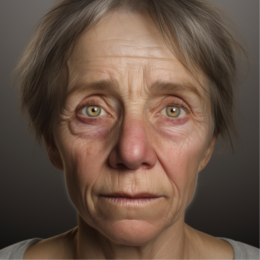What is Prostate Cancer? A Comprehensive Guide

We thought you might like these too…
What Do You Do When a Cancer Patient Won’t Eat? (4 Solutions)
Diet for Cancer Patients: A Comprehensive Guide
What Is Targeted Therapy for Cancer? (Everything You Need to Know)
Prostate cancer remains a significant concern among men worldwide. With a myriad of information available, understanding this condition can be overwhelming. This article aims to provide a comprehensive overview, from understanding the prostate gland to prevention and personal experiences.
The Prostate Gland
Description and Location of the Prostate Gland
Situated below the bladder and in front of the rectum, the prostate gland is about the size of a walnut. It surrounds the urethra, the tube that carries urine and semen out of the body.
Functions of the Prostate Gland
Beyond its role in the male reproductive system, the prostate gland produces a thick, milky fluid that nourishes the sperm, forming a significant portion of the ejaculate.
Role in the Male Reproductive System
The prostate fluid produced by this gland plays a crucial role in protecting and nourishing sperm, facilitating its movement and survival.
Prostate Cancer Defined
Prostate cancer is a malignant growth that begins in the prostate gland, an integral part of the male reproductive system. While it’s one of the most common types of cancer in men, not all prostate cancers are aggressive, and many can grow slowly, requiring minimal or even no treatment. Understanding its types and prevalence can provide clarity on its impact.
Types of Prostate Cancer

- Adenocarcinoma: This is the most common subtype, originating in the prostate gland cells. The majority of prostate cancers are adenocarcinomas.
- Transitional Cell Carcinoma: Originating in the bladder, this type can invade the nearby prostate gland.
- Sarcomas: These are rare types of prostate cancer that begin in the muscle tissues of the prostate.
- Small Cell Carcinomas: Another rare type, small cell carcinomas, are aggressive and tend to spread quickly.
- Neuroendocrine Tumors: These are rare and can be benign or malignant.
- Prostatic Intraepithelial Neoplasia (PIN): While not a cancer, PIN is a condition where abnormal cells are found on the lining of the prostate gland. High-grade PIN might be associated with a higher risk of cancer.
Prevalence and Incidence Rates
Prostate cancer stands as a leading cause of cancer diagnosis among men. The statistics are alarming: out of every 100 American men, about 13 will be diagnosed with prostate cancer during their lifetime, with 2-3 succumbing to the disease. The prevalence of this disease underscores the importance of awareness, early detection, and proactive management.
Causes and Risk Factors
Understanding prostate cancer’s causes and risk factors is vital for early detection and prevention. Here are the primary factors:
- Age: The risk of prostate cancer increases with age. Men over 65 are particularly susceptible.
- Race/Ethnicity: African-American men face a higher risk and are often diagnosed at a younger age with more advanced disease7.
- Genetics: Having a first-degree relative with prostate cancer can double the risk7. Specific inherited gene mutations can also increase the likelihood.
- Diet: A diet high in red meat and low in fruits and vegetables might increase the risk.
- Geography: Prostate cancer is more common in North America, northwestern Europe, Australia, and the Caribbean islands.
- Chemical Exposure: Veterans exposed to Agent Orange during the Vietnam War have a higher risk.
- Medications: Some studies suggest that men who take certain medications might have an increased risk, though more research is needed.
Symptoms of Prostate Cancer
Prostate cancer symptoms can vary; the disease might be asymptomatic in many cases, especially in the early stages. However, as the cancer progresses, men might experience:
Early-Stage Symptoms
- Frequent urination, especially at night.
- Difficulty starting or maintaining a urine stream.
- Weak or interrupted urine flow.
- Painful urination or blood in the urine.
- Erectile dysfunction.
Advanced-Stage Symptoms
- Persistent bone pain, especially in the back, hips, or thighs.
- Unexplained weight loss.
- Fatigue.
- Swelling in the legs or pelvic area.
- Numbness or pain in the hips, thighs, or lower back.
Asymptomatic Cases
Many men may not exhibit any symptoms, especially in the early stages. This makes regular screenings crucial for early detection and treatment.
Importance of Regular Check-Ups
Since early-stage prostate cancer might not present symptoms, regular check-ups are essential. Screenings, including the PSA test and digital rectal exams, can detect abnormalities that might indicate the presence of cancer.
Survey
Treatment Options
Active Surveillance
For low-risk cancers, monitoring without immediate treatment might be recommended.
Surgery
A radical prostatectomy involves removing the prostate gland and some surrounding tissue.
Radiation Therapy
This involves using high-energy rays to target and kill cancer cells, either externally or through implanted radioactive seeds.
Hormone Therapy for Cancer
What is hormone therapy for cancer? It aims to reduce testosterone levels, slowing the growth of cancer cells. By limiting the body’s production of testosterone, a hormone that fuels prostate cancer growth, the progression of the disease can be controlled3.
Chemotherapy
Used for advanced stages, chemotherapy kills rapidly growing cells, including cancer cells.
Immunotherapy
This boosts the body’s natural defenses, helping it recognize and attack cancer cells.
Emerging Therapies and Clinical Trials
Innovative treatments are continually being researched. The FDA’s recent approval of a combination treatment for advanced prostate cancer is a testament to ongoing advances.
Living with Prostate Cancer
Adopting a healthy lifestyle, including a balanced prostate cancer diet, can aid in managing the disease and improving quality of life4. Regular exercise, stress management, and joining support groups can also be beneficial.
Prevention and Prostate Health
Which kind of diet helps prevent cancer? A diet rich in fruits, vegetables, and whole grains while limiting red meats can play a pivotal role in cancer prevention4. Regular screenings and understanding the risks are also paramount.
James’ Journey
James, a 65-year-old retired teacher, was diagnosed with prostate cancer two years ago. Initially devastated, he now champions the importance of regular check-ups, a balanced diet, and a positive outlook. His journey, filled with ups and downs, is a beacon of hope for many.
Conclusion
Prostate cancer, while daunting, is manageable with early detection, the right treatment, and a supportive community. We urge our readers to share their experiences, fostering a space of understanding and empathy.
References
- American Cancer Society. “Key Statistics for Prostate Cancer.” URL: https://www.cancer.org/cancer/prostate-cancer/about/key-statistics.html
- National Cancer Institute. “Prostate Cancer Treatment (PDQ®)–Patient Version.” URL: https://www.cancer.gov/types/prostate/patient/prostate-treatment-pdq
- Mayo Clinic. “Prostate Cancer: Symptoms & Causes.” URL: https://www.mayoclinic.org/diseases-conditions/prostate-cancer/symptoms-causes/syc-20353087
- World Cancer Research Fund. “Diet, Nutrition, Physical Activity, and Prostate Cancer.” URL: https://www.wcrf.org/dietandcancer/prostate-cancer/
- Harvard Health Publishing. “FDA approves new drug for advanced prostate cancer.” URL: https://www.health.harvard.edu/blog/fda-approves-new-treatment-for-advanced-prostate-cancer-202307122952
- The Prostate Cancer Foundation. “The Science of Living Well, Beyond Cancer.” URL: https://www.pcf.org/guide/wellness-guide/
- Centers for Disease Control and Prevention (CDC). “What Are the Risk Factors for Prostate Cancer?” URL: https://www.cdc.gov/cancer/prostate/basic_info/risk_factors.htm
- The Urology Care Foundation. “Is Prostate Cancer Screening Right for Me? URL: https://www.urologyhealth.org/urology-a-z/p/prostate-cancer/prostate-cancer-pdf





